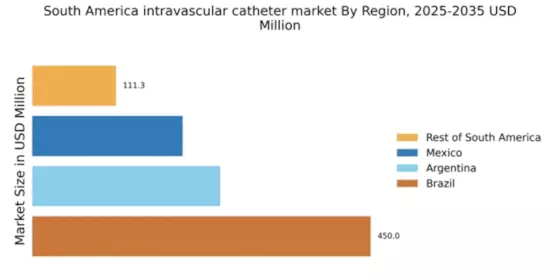Expansion of Healthcare Infrastructure
The ongoing expansion of healthcare infrastructure across South America serves as a crucial driver for the intravascular catheter market. Governments and private entities are investing heavily in healthcare facilities, aiming to improve access to medical services. For instance, Brazil and Argentina have initiated several projects to enhance hospital capacities and upgrade medical equipment. This investment is projected to increase the number of procedures requiring intravascular catheters, thereby boosting market growth. Additionally, the establishment of specialized healthcare centers is likely to create a higher demand for advanced medical devices. As the healthcare infrastructure continues to evolve, the intravascular catheter market is poised to benefit from increased utilization rates and a broader range of applications in patient care.
Increasing Prevalence of Chronic Diseases
The rising incidence of chronic diseases in South America is a pivotal driver for the intravascular catheter market. Conditions such as diabetes, cardiovascular diseases, and cancer necessitate frequent medical interventions, thereby increasing the demand for intravascular catheters. According to health statistics, chronic diseases account for approximately 60% of all deaths in the region, highlighting the urgent need for effective treatment options. This trend is likely to propel the growth of the intravascular catheter market, as healthcare providers seek reliable solutions for patient management. Furthermore, the increasing aging population in South America, which is projected to reach 20% by 2030, further exacerbates the demand for these medical devices. As healthcare systems adapt to these challenges, the intravascular catheter market is expected to expand significantly in response to the growing healthcare needs of the population.
Technological Innovations in Catheter Design
Technological innovations in catheter design are transforming the intravascular catheter market in South America. Advances such as the development of antimicrobial coatings, improved materials, and smart catheters are enhancing the performance and safety of these devices. For example, the introduction of catheters with integrated sensors for real-time monitoring is gaining traction among healthcare providers. These innovations not only improve patient outcomes but also reduce the risk of complications associated with catheter use. The market for advanced catheters is projected to grow significantly, with estimates suggesting a CAGR of 8% over the next five years. As these technologies become more prevalent, the intravascular catheter market is expected to expand, driven by the demand for safer and more effective medical solutions.
Rising Awareness of Minimally Invasive Procedures
There is a growing awareness and preference for minimally invasive procedures among healthcare professionals and patients in South America. This trend is significantly influencing the intravascular catheter market, as these devices are integral to various minimally invasive techniques. The advantages of reduced recovery times, lower risk of complications, and enhanced patient comfort are driving the adoption of such procedures. Market data indicates that minimally invasive surgeries are expected to grow at a CAGR of 10% in the region, further solidifying the role of intravascular catheters in modern medical practices. As healthcare providers increasingly adopt these techniques, the intravascular catheter market is likely to experience substantial growth, reflecting the shift towards more patient-centric care.
Government Initiatives to Improve Healthcare Access
Government initiatives aimed at improving healthcare access in South America are playing a vital role in driving the intravascular catheter market. Policies focused on expanding insurance coverage and subsidizing medical devices are making healthcare more accessible to a larger segment of the population. For instance, several countries have implemented programs to provide free or low-cost medical services, which include the use of intravascular catheters for various treatments. This increased accessibility is likely to lead to a higher volume of procedures requiring these devices. As healthcare systems evolve to meet the needs of their populations, the intravascular catheter market is expected to grow, reflecting the positive impact of government efforts on healthcare delivery.


















Leave a Comment